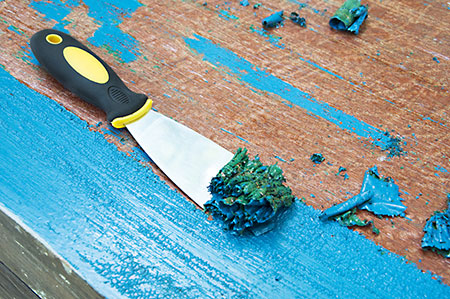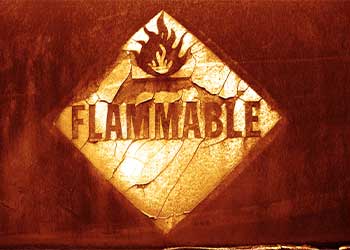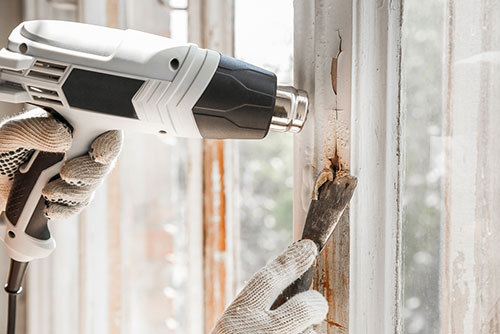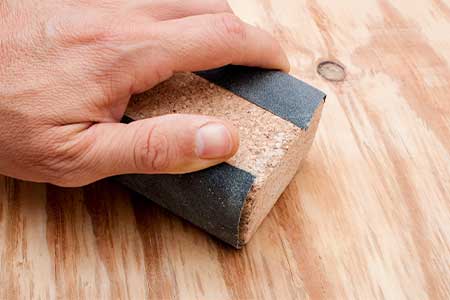There are a host of reasons why you would want to remove paint from wood. If you accidentally get paint on a wooden surface while you are painting something else if someone has previously painted an item and you would prefer the natural look of the wood, and during a renovation process.
The question of how to remove spray paint from wood sounds very straightforward, but in truth, there are different methods of removing the paint, and different things to consider like the condition of the wood, the age of the paint, the type of paint, etc.
What to Use to Get Paint off Wood
First identify the problem, such as a small spot of paint that was accidentally transferred, or a painted piece of furniture that has been covered in paint and a polyurethane coating. This determination will help you decide which products and materials will be best suited to the task.
Frequently Used Materials Include:
- Sandpaper
- Commercial paint strippers
- Acetone
- Mineral spirits or turpentine
- Denatured alcohol
- White vinegar
- Heat guns
Step-by-Step Guide Using a Commercial Paint Stripper
Commercially manufactured paint strippers are the easiest method of removing paint from wood, especially if you are covering a large surface or an entire surface. These products are designed to blister and dissolve the paint without doing lasting damage to the wooden surface.
Tools You Will Need

- A scraper (plastic scrapers are less likely to damage the wooden surface)
- Cleaning cloth
- Plastic gloves to protect your hands
- Goggles or eyewear that will protect your eyes
- Sandpaper (You may need an electric sander if you are working on a large piece, but smaller items can be sanded using just the paper, or a sanding block)
- Paint brush
Materials You Need
- Commercial paint stripper of choice
- Newspaper or drop cloth to protect the surface under the wooden item
Step 1 – Clean the item thoroughly to remove all paint and contaminants from it. Once clean the item needs to dry before you can begin removing the paint.
Step 2 – Use the paintbrush to apply a small amount of the commercial paint stripper to the surface. It is best to work in small sections at a time to complete the removal before the paint stripper dries in place.
- Paint the substance on the wooden surface
- Leave the stripper in place for about 10 to 20 minutes. (Each manufacturer will have in-depth details on how long the product needs to be allowed to work. Read the label on the stripper carefully and always follow manufacturer guidelines.)
- Watch for signs of the paint beginning to loosen like blistering or bubbling
Step 3 – Take the plastic scraper and gently begin to remove the old paint that has been loosened by the product. Wipe the material onto an old newspaper or paper towel to clean it off of the scraper as you work. Be very careful not to let this old paint touch your skin because commercial strippers can cause minor burns or irritations.
Step 4 – Wipe the item off using a dry cloth to see how much paint is still adhering to the item. If there is still a great deal of paint you want to repeat the application of the stripper and the use of the scraper until you have removed as much of the paint as possible.
Step 5 – When the wood is dry you will take sandpaper and go over the entire surface area. The sandpaper will remove the tiny portions of paint that are still adhering to the wood, and it will make the wood smooth. The sanding process is slow but you have to do it if you want the paint to be completely eradicated from the wood.
Drawbacks of Paint Strippers
- They can be expensive
- They are messy to use
- They do not do an excellent job of removing heavy paint
- They often have a strong odor
- They can be hazardous to your health and must be handled with extreme caution
Benefits of Using Commercial Paint Strippers
- They create a cleaner look when finished
- They do not stain or damage the wood
- They are gentle enough to use on old beams and antique pieces
Concerns and Warnings

- Paint strippers are often flammable so you should not smoke while using these items.
- Store these chemicals out of reach of children.
- Never store paint strippers close to a flame source, such as a hot water heater.
- Do not mix chemicals together in an attempt to remove paint. You can create a toxic substance if you do.
- Always wear eye protection when using these chemicals because they can do great damage if they get in your eye.
- Always wear gloves to protect your hands because these chemicals can cause burns and irritation of the skin.
- Wear a face mask or respirator while using these chemicals
- Do not toss the old rags and paper with the chemicals on them in your household trash. You need to dispose of these items according to the city and fire regulations established in your area.
Tips from the Pros
- NEVER let a commercial paint stripper dry on the surface because when they dry they adhere to the wood and are very difficult to remove.
- Only remove paint in a well-ventilated area to avoid toxic fumes and breathing difficulties
- Never try to sand wood that is still damp or you will only create a clumpy mess on the surface.
- Use a fine grit of sandpaper or you could scratch the wood.
- Be careful with your scraper. You want to hold it at an angle and let it make contact with the surface but do not let it gouge the wood.
- Do not use a heat gun to remove lead paint. If you do not know if the paint contains lead then ere on the side of caution and treat it like it does.
Removing Paint from Wood with Heat Guns

Heat guns are capable of directing heat at such high temperatures that the paint on an object will blister, peel, or dissolve. Be careful with these devices because the heat is high enough to actually damage the material so you need to not blast heat at one spot for long periods of time. You also want to make sure that you make no contact with the heat gun while it is in operation or while it is cooling after use.
Benefits of Heat Guns
- They work fast
- They are not messy and do not create a big mess
Drawbacks of Using Heat Guns
- They are potential fire hazards
- They can burn you
- They can damage the material
Sanding for Removing Paint from Wood

If the project is small sanding is probably the best option. Sandpaper rubs against the paint and makes it break away from the surface. This process can remove all of the paint, and it will leave the surface smooth.
When sanding be careful to not rub one place for so long that you cause the material to be made thin. Also, do not gouge the wood. You need to go slow while sanding and use a steady, and gentle amount of pressure to remove the paint without damaging the surface.
Final Thoughts
Removing paint is not easy. Removing paint from wood requires you to be patient, diligent, and determined. It is completely possible to totally remove the paint without damaging the surface material. When the paint is removed, and the surface is clean and sanded, you cannot put a price tag on the rewarding feeling you will have from your hard work.
Frequently Asked Questions
How do You Get Paint off Wood Without Damaging it?
Substances like denatured alcohol, white vinegar, or commercial paint strippers can be used to help dissolve the paint and break away the adherence qualities. The main thing you need when removing paint from wood is patience, this is not a fast process.
What is the Easiest Way to Remove Paint from Wood?
Commercial paint stripper followed by sanding the remaining paint away.
How to Get Spray Paint Off Wood Deck?
You should start with a paint stripper and try to make the paint bubble up. You will have to finish the job with a piece of sandpaper to completely remove the paint.
What is the Best Paint Remover for Wood?
One of the most frequently bought paint removers is the Citri stripping gel. It is gentle on the wood, and it is thick and easy to apply.
You may also like to read:
1. How to Remove Silicone Caulk From Fiberglass Shower Stall?
2. How to Clean Flat Paint Walls and Leave Them Spotless
